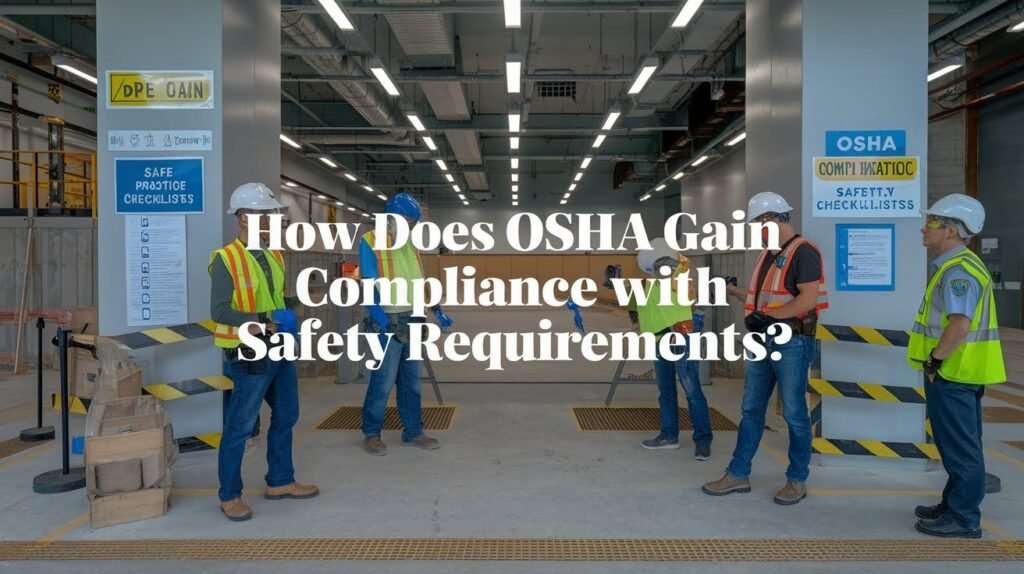Every day, workers face dangers at their jobs. Some are obvious. Others hide in plain sight. That’s where OSHA steps in. But how exactly does OSHA get companies to follow safety rules? You’re about to find out.
In this guide, I’ll show you OSHA’s proven strategies for gaining workplace compliance. You’ll learn about their education programs, enforcement methods, and collaborative approaches. I’ll also reveal the common barriers companies face and how to overcome them.
Here’s why you can trust this information: I’ve studied OSHA’s compliance methods for years and worked with companies handling these requirements. This isn’t theory. These are real-world strategies that protect millions of workers daily.
If you’re an employer trying to stay compliant or a worker wanting to understand your rights, this article answers your questions about OSHA’s compliance process. Let’s look at exactly how OSHA ensures workplace safety across America.
What is OSHA and Its Role in Workplace Safety?

The Occupational Safety and Health Administration (OSHA) is like a safety watchdog for American workers.
Created in 1970, OSHA has one main job: keep you safe at work.
Think of OSHA as your workplace safety guardian. They create rules. They check if companies follow them. And they take action when they don’t.
Here’s what OSHA does every single day:
- Sets safety standards for different industries
- Inspects workplaces across the country
- Trains workers and employers
- Investigates accidents and complaints
- Issues fines when rules are broken
Without OSHA, workplace deaths would be much higher. In fact, workplace fatalities have dropped by more than 60% since OSHA began.
OSHA’s Core Strategies to Gain Compliance
OSHA doesn’t just hope companies will follow safety rules. They have a plan. Actually, they have several strategies working together.
1. Education and Training Initiatives
Knowledge is power. OSHA knows this. That’s why education comes first in their compliance strategy.
OSHA’s Training Programs Include:
- Free consultation services for small businesses
- Online safety courses for workers
- Workplace safety seminars
- Industry-specific training materials
- Multilingual safety resources
I’ve seen companies change after OSHA training. Workers learn to spot hazards. Managers understand their legal duties. Everyone wins.
But here’s the thing: OSHA makes training accessible to everyone. They offer courses in multiple languages. They provide free materials. They even come to your workplace to help.
Why does this work? Simple. When people understand the rules, they’re more likely to follow them.
2. Regulations and Standards
Rules without teeth are just suggestions. OSHA creates detailed safety standards for different industries. These aren’t vague guidelines. They’re specific requirements with measurable outcomes.
Examples of OSHA Standards:
- Construction workers must wear hard hats in certain areas
- Chemical companies must provide safety data sheets
- Hospitals need bloodborne pathogen protection programs
- Factories require machine guarding on equipment
Each standard tells you exactly what to do. No guessing involved. The beauty of clear standards? You know what’s expected. OSHA knows what to check. Everyone stays on the same page.
3. Inspections and Audits
This is where the rubber meets the road. OSHA inspectors show up at workplaces. Sometimes announced. Sometimes not.
When OSHA Inspects:
- After workplace accidents
- Following worker complaints
- During random compliance checks
- In high-risk industries
- When they receive tips about violations
During inspections, OSHA looks at everything. Your safety equipment. Your training records. How you handle dangerous materials. They talk to workers. They examine your workplace. They check if you’re following the rules.
Here’s what surprises most employers: OSHA inspectors want to help. They’re not just looking for problems. They want to prevent accidents.
Enforcement Mechanisms: How OSHA Compels Compliance
What happens when companies ignore safety rules?
OSHA has several ways to get their attention. Financial Penalties Money talks. OSHA knows this. When companies violate safety standards, they face fines. These aren’t small amounts either.
Serious violations can cost up to $16,131 per violation. Willful violations reach up to $161,323 per violation. Repeat violations also cost up to $161,323 per violation.
Large companies can face millions in fines.
Criminal Prosecution In extreme cases, OSHA refers violations to the Department of Justice.
This happens when companies willfully ignore safety rules, when workers die because of safety violations, or when employers lie to investigators.
Work Stoppage Orders OSHA can shut down dangerous operations immediately. If workers face imminent danger, OSHA stops work until the problem is fixed.
Imagine losing thousands of dollars per hour because you ignored a safety rule. That gets attention fast. Public Disclosure OSHA publishes violation information online. Your company’s safety failures become public record. Customers see them. Competitors see them. Everyone sees them.
This public shame often motivates compliance more than fines.
Collaborative Programs that Encourage Voluntary Compliance
Not everything OSHA does involves punishment. They also offer carrots instead of sticks.
Voluntary Protection Programs (VPP)
Companies with excellent safety records can join VPP.
Benefits include:
- Reduced inspection frequency
- Public recognition for safety excellence
- Networking with other safety leaders
- Technical assistance from OSHA
Alliance Program
OSHA partners with trade associations, unions, and educational institutions.
Together, they:
- Develop safety training materials
- Share best practices
- Promote safety awareness
- Create industry-specific guidance
Consultation Services
Small businesses get free safety consultations.
OSHA experts visit your workplace. They identify hazards. They suggest solutions. And they don’t issue citations during these visits.
This program helps thousands of small businesses improve safety without fear of penalties.
Common Barriers to OSHA Compliance
Why do some companies struggle with OSHA compliance?
Let me share the most common reasons:
Lack of Understanding Many employers don’t fully understand OSHA requirements. Safety rules can seem complex. Different industries have different standards. It’s easy to get confused.
Cost Concerns Some companies worry about compliance costs. Safety equipment costs money. Training takes time. Some employers see this as an unnecessary expense.
Competing Priorities Business owners juggle many responsibilities. Safety sometimes takes a backseat to production deadlines or profit goals.
Inadequate Resources Small companies often lack dedicated safety staff. They want to comply but don’t know how to start.
Poor Communication Safety information doesn’t always reach the right people. Managers might know the rules, but workers don’t. Or vice versa.
How Employers Can Stay Compliant Proactively
You don’t have to wait for OSHA to knock on your door.
Make safety part of your company’s DNA. Start safety meetings with safety topics and reward safe behavior. Encourage workers to report hazards and lead by example. Check your workplace regularly. Look for hazards before OSHA does. Fix problems immediately and document everything.
OSHA requires specific recordkeeping. Maintain injury and illness logs, training records, inspection reports, and safety meeting minutes. OSHA standards change. Subscribe to OSHA updates and join industry safety groups. Attend safety conferences and work with safety consultants.
Educated workers are safer workers. Provide regular safety training and make sure everyone understands their role in workplace safety. Modern tools make compliance easier. Safety management software tracks training while mobile apps report hazards instantly. Digital inspections save time.
The Future of OSHA Compliance
OSHA continues evolving.
What’s coming next? Increased Focus on Mental Health. Workplace stress and mental health are gaining attention.
OSHA is developing guidance for psychological safety at work. Technology Integration
Digital tools are changing how OSHA works:
- Electronic injury reporting
- Virtual inspections
- Online training platforms
- Data analytics for targeting inspections
Industry-Specific Approaches OSHA is customizing compliance strategies for different industries. What works in construction might not work in healthcare. Specific approaches get better results.
Global Coordination As businesses become more global, OSHA coordinates with international safety organizations. This ensures consistent safety standards across borders.
Prevention Focus OSHA is shifting from reactive to proactive enforcement. Instead of just responding to accidents, they’re preventing them.
Conclusion
OSHA’s compliance strategy works because it uses multiple approaches at once.
Education teaches companies what to do. Inspections check if they’re doing it. Enforcement makes non-compliance expensive. Collaboration rewards good behavior.
This balanced method reaches different types of employers. Some learn from training. Others need the fear of fines. Most respond to a mix of both.
The results speak for themselves. Workplace deaths have dropped dramatically since OSHA began operations. Millions of workers go home safely each day because of these compliance efforts.
Your workplace safety depends on OSHA’s ability to gain compliance. When companies follow safety rules, fewer people get hurt. That’s good for workers, families, and businesses alike.
Understanding how OSHA gains compliance helps you stay safer at work. It also shows why workplace safety regulations matter so much in protecting American workers.
Frequently Asked Questions
How often does OSHA inspect workplaces?
OSHA inspects about 40,000 workplaces each year across the United States. With limited staff, they prioritize high-risk industries, accident sites, and workplaces with worker complaints.
Can OSHA shut down my business immediately?
Yes, OSHA can issue immediate work stoppage orders if workers face imminent danger. However, this only happens in extreme situations where continuing work could result in serious injury or death.
What happens if I refuse to let OSHA inspect my workplace?
OSHA can obtain a court warrant to force entry if you refuse inspection. Blocking an OSHA investigation can result in additional penalties and criminal charges in some cases.
Do small businesses get different treatment from OSHA?
Small businesses with fewer than 10 employees are exempt from routine inspections and some recordkeeping requirements. OSHA also offers free consultation services specifically designed for small businesses.
How long do I have to fix OSHA violations?
OSHA typically gives employers 15 to 30 days to correct violations, depending on severity. Serious hazards requiring immediate attention must be fixed right away or work must stop.


